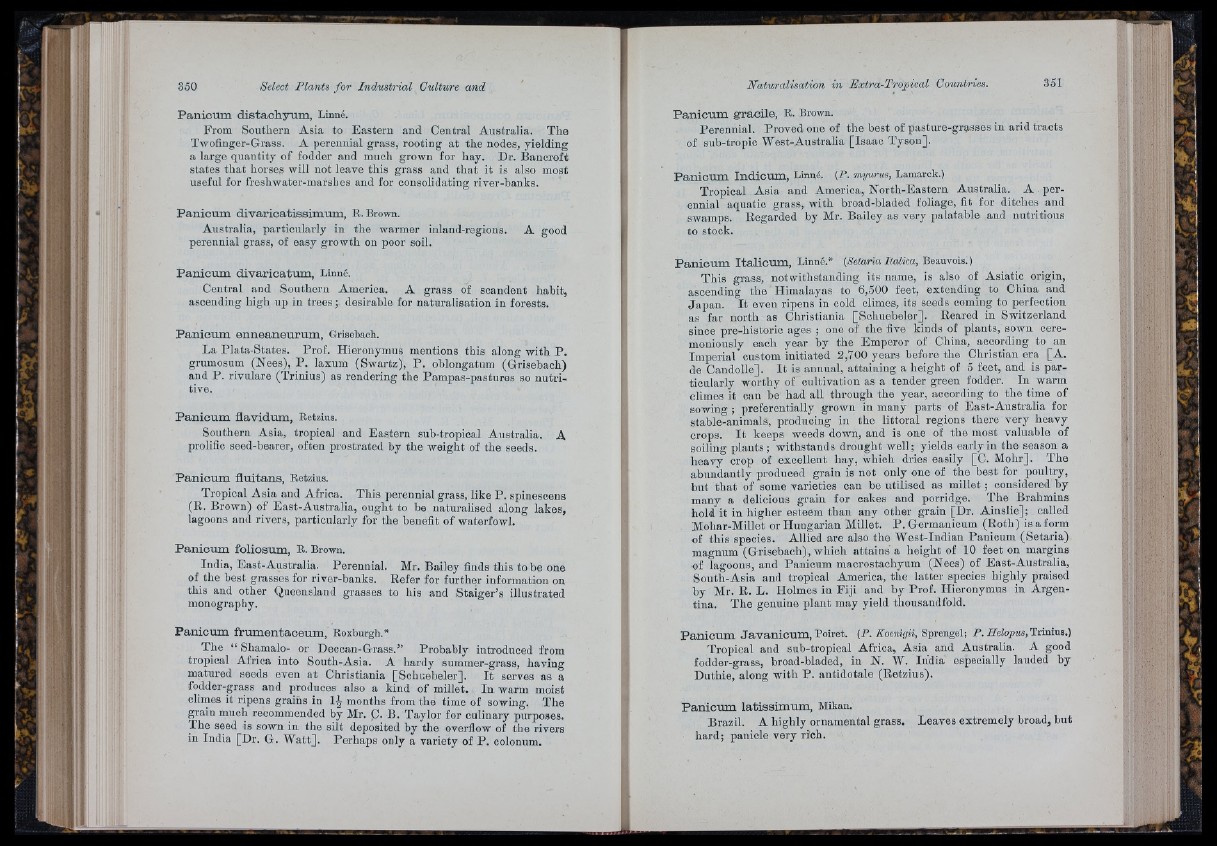
P a n ic um d is ta c h y um , Línuó.
From Southern Asia to Eastern and Central Australia. The
Twofinger-Grass. A perennial grass, rooting a t the nodes, yielding
a large quantity of fodder and much grown for hay. Dr. Bancroft
states that horses will not leave this grass and th a t it is also most
useful for freshwater-marsbes and for consolidating river-banks.
P a n ic um d iv a r ic a tis s im um , R. Brown.
Australia, particularly iu tlie warmer inland-regions.
perennial grass, of easy growth on poor soil.
A good
P a n ic um d iv a r ic a tum , Linné.
Central and Southern America. A grass of scandent habit,
ascending high np in tre e s; desirable for naturalisation in forests.
P a n ic um e n n e a n e u rum , Grisebach.
La Plata-States. Prof. Hieronymus mentions this along with P .
grumosum (Nees), P . laxmn (Swartz), P . oblongatum (Grisebach)
and P. rivulare (Trinius) as rendering the Pampas-pastures so n u tritive.
P a n ic um fla v id um , Retzius.
Southern Asia, tropical and Eastern sub-tropical Australia. A
prolific seed-bearer, often prostrated by the weight of the seeds.
P a n ic um ñ u ita n s , Retzius.
Tropical Asia and Africa. This perennial grass, like P . spineseens
(R. Brown) of East-Australia, ought to be naturalised along lakes,
lagoons and rivers, particularly for the benefit of waterfowl.
P a n ic um fo lio sum , R. Brown.
India, East-Australia. Perennial. Mr. Bailey finds this to be one
of the best grasses for river-banks. Refer for further information on
this and other Queensland grasses to his and Staiger’s illustrated
monograpiiy.
P a n ic um f rum e n ta c e um , Roxburgh.*
The “ Shamalo- or Deocan-Grass.” Probably introduced from
tropical Africa into South-Asia. A hardy summer-grass, having
matured seeds even a t Christiania [Schuebeler]. I t serves as a
fodder-grass and produces also a kind of millet. In warm moist
climes it ripens grains in months from the time of sowing. The
p a in much recommended by Mr. Q. B. Taylor for culinary purposes.
The seed is sown in the silt deposited by the overflow of the rivers
in India [Dr. G. Wa tt]. Perhaps only a variety of P . colonum.
P a n ic um g ra c ile , R. Brown.
Perennial. Proved one of tho best of pasture-grasses in arid tracts
of sub-tropic West-Australia [Isaac Tyson].
P a n ic um In d ic um , Linné. (P. myurm, Lamarck.)
Tropical Asia and America, North-Eastern Australia. A perennial
aquatic grass, with broad-bladed foliage, fit for ditches and
swamps. Regarded by Mr. Bailey as very palatable aud nutritious
to stock.
P a n ic um I ta lic um , Linné.* (Setaria Itálica, Beauvois. )
This grass, notwithstanding its name, is also of Asiatic origin,
ascending the Himalayas to 6,500 feet, extending to China and
Japan. I t even ripens in cold climes, its seeds coming to perfection
as far north as Christiania [Sclmebeler]. Reared in Switzerland
since pre-historic ages ; one of the five kinds of plants, sown ceremoniously
each year by the Emperor of China, according to an
Imperial custom initiated 2,700 years before the Christian era [A.
de Candolle]. I t is annual, attaining a height of 5 feet, and is particularly
worthy of cultivation as a tender green fodder. In warm
climes it can be had all through the year, according to tlie time of
sowing ; preferentially grown in many parts of East-Australia for
stable-animals, producing in the littoral regions there very heavy
crops. I t keeps weeds down, and is one of the most valuable of
soiling plants; withstands drought well; yields early in the season a
heavy crop of excellent hay, which dries easily [C. Molir]. The
abnndantly produced grain is not only one of the best for poultry,
but th a t of some varieties can be utilised as millet ; considered by
many a delicious grain for cakes and porridge. The Brahmins
hold it in higher esteem than any other grain [Dr. Ainslie]; called
Mohar-Millet or H ungarian Millet. P . Germanicum (Roth) is a form
of this species. Allied are also the West-Indian Panicum (Setaria)
magnum (Grisebach), whicli attains a height of 10 feet on margins
of lagoons, and Panicum macrostachyum (Nees) of East-Australia,
South-Asia and tropical America, the latter species highly praised
by Mr. R. L. Holmes in Fiji and by Prof. Hieronymus in Argentina.
The genuine plant may yield thousandfold.
P an icum . J a v a n i c u m , Poiret. (P . Aoenicrii, Sprengel; P . Aeiopiis, Trinius.)
Tropical and sub-tropical Africa, Asia and Australia. A good
fodder-grass, broad-bladed, in N. W. India especially lauded by
Duthie, along with P. antidótale (Retzius).
P a n ic um la tis s im um , Mikan.
Brazil. A highly ornamental grass,
hard; panicle very rich.
Leaves extremely broad, but
I q
i-t[
M
i l l
t e i
M I r u
l l Ê